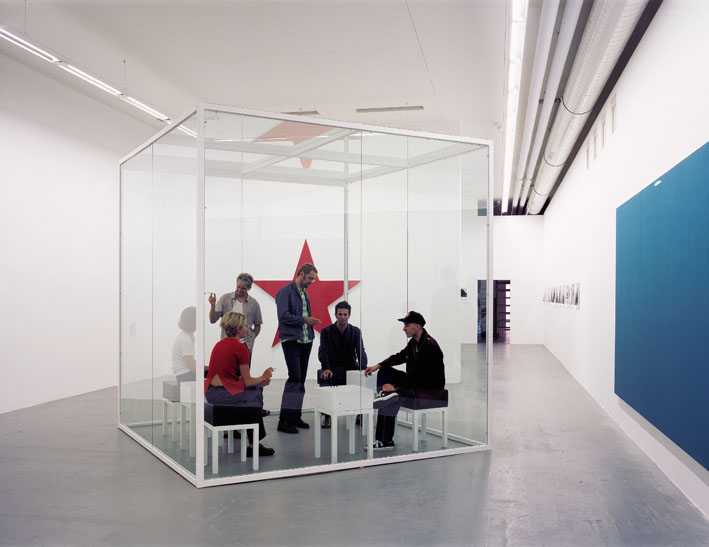Zurich , 1998
CONTEMPLATION ROOM
The only museum where you can smoke while contemplating art.
Glass room with 2 ashtrays and 4 same-sized chairs.
Collection Migros Museum, Zurich, Switzerland.
He is gone. I clean the house, throw away the remnants of his stay: the shaving cream, the shoelace ends, the ashtray. I buy a necklace, perfume, a haircut and bulbs. It’s the domestic ritual to banish my thoughts of him. Everyone has such rituals, I suppose. What’s more, any house contains the possibility of ritually erasing the traces of its inhabitants. The cleaning is a means of re-conquering space. The house doesn’t store the memory in itself; it isn’t tied to our past. Instead, we can use it to release ourselves from our former life.
Rules for sanitation are meant to keep us from degenerating. The greater the fear of dying, growing old or losing in any another way, the bigger our need to take control. Present laws against smoking are a vigorous effort to express our ability to shape our world; they reflect the longing for a ritualistic attempt to make our environment fresh. By banishing smokers from the public space we identify the danger in such a way that we can eliminate it.
The fashion of purifying air is reflected in architecture. New halls and lobbies appear between the office blocks and the streets. The smoking areas are dark, all marble with big ashtrays and no seats. These places are not fit to enjoy a cigarette and think, rest or talk; they are transit areas, designed to encourage workers to take shorter breaks. Buildings where nobody smokes take on an artificial smell, like in waiting rooms. Here the smokers mimic adolescents: longing for privacy they hang out in toilets, on the pavement, the fire escape staircase. These are the places of refuge. After moving out of the way, a smoker has no other way to rebel. As at school, smoking is an act of self- assertion as well as submission. Architects and designers take the place of the schoolteacher, who takes for granted that some pupils will be outcasts.
The exact position of your lips on a cigarette has been tested out in the tobacco industry. The duration of one cigarette has also been calculated. Law restricts where you can smoke and the moments you can light up.
(Smoke gets in your eyes)
You inhale, hold your breath and exhale. Smoking brings you into another state, emotionally and physically. The desire of that state is stronger than the fear of a shorter life, stronger than the fear of getting ill, or being the loser that being out there on the pavement suggests.

He is gone. I clean the house, throw away the remnants of his stay: the shaving cream, the shoelace ends, the ashtray. I buy a necklace, perfume, a haircut and bulbs. It’s the domestic ritual to banish my thoughts of him. Everyone has such rituals, I suppose. What’s more, any house contains the possibility of ritually erasing the traces of its inhabitants. The cleaning is a means of re-conquering space. The house doesn’t store the memory in itself; it isn’t tied to our past. Instead, we can use it to release ourselves from our former life.
Rules for sanitation are meant to keep us from degenerating. The greater the fear of dying, growing old or losing in any another way, the bigger our need to take control. Present laws against smoking are a vigorous effort to express our ability to shape our world; they reflect the longing for a ritualistic attempt to make our environment fresh. By banishing smokers from the public space we identify the danger in such a way that we can eliminate it.
The fashion of purifying air is reflected in architecture. New halls and lobbies appear between the office blocks and the streets. The smoking areas are dark, all marble with big ashtrays and no seats. These places are not fit to enjoy a cigarette and think, rest or talk; they are transit areas, designed to encourage workers to take shorter breaks. Buildings where nobody smokes take on an artificial smell, like in waiting rooms. Here the smokers mimic adolescents: longing for privacy they hang out in toilets, on the pavement, the fire escape staircase. These are the places of refuge. After moving out of the way, a smoker has no other way to rebel. As at school, smoking is an act of self- assertion as well as submission. Architects and designers take the place of the schoolteacher, who takes for granted that some pupils will be outcasts.
The exact position of your lips on a cigarette has been tested out in the tobacco industry. The duration of one cigarette has also been calculated. Law restricts where you can smoke and the moments you can light up.
(Smoke gets in your eyes)
You inhale, hold your breath and exhale. Smoking brings you into another state, emotionally and physically. The desire of that state is stronger than the fear of a shorter life, stronger than the fear of getting ill, or being the loser that being out there on the pavement suggests.